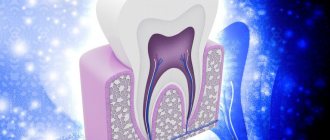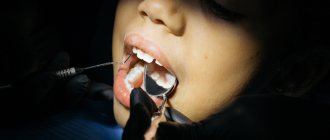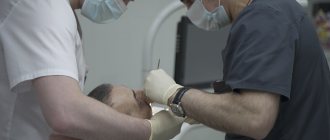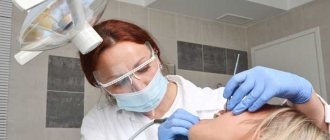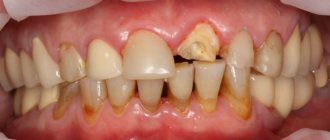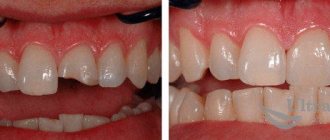There are a number of reasons (trauma, caries, short crown) why only the root and a small part of the crown remain from the tooth, and the rest of the dental tissue is lost. Until recently, in this case, fillings, a prosthesis were installed, or a tooth was removed. Currently, it is possible to use restoration options that allow you to recreate the original appearance of the tooth. The restored tooth looks natural and aesthetically pleasing. An important condition is that the root must be intact. Computer technology is used to create a copy of the crown of a future tooth.
Indications and contraindications for tooth augmentation
Teeth augmentation is a multi-stage technology for restoring the aesthetic appearance and functions of the jaw, which was susceptible to chipping or erased as a result of increased tone of the masticatory muscles, called buxism.
Indications for the tooth augmentation procedure:
- chips resulting from injuries;
- numerous caries lesions;
- large distance between teeth;
- wedge-shaped defect;
- the presence of a gap between the two front teeth;
- congenital structural pathologies;
- thinning and demineralization of enamel due to consumption of junk food and lack of oral hygiene;
- cervical caries;
- the presence of errors in previous dental sessions that resulted in the destruction of healthy tissue;
- malocclusion.
Having asked the dentist a question about what tooth extension is called, the patient will immediately hear the answer. The procedure is called dentition restoration. Modern extension technologies make it possible to restore the structure in most cases without resorting to its removal. The procedure is harmless, but has a number of contraindications:
- patient age – more than 60 years;
- children's age when using pins;
- presence of a cyst;
- inflammation of the gums;
- pregnancy in the first or third trimester;
- failure to comply with personal hygiene rules;
- periodontitis and stomatitis;
- jaw fracture and other injuries.
If a patient is diagnosed with diseases that are contraindications, the dentist first treats them, and then restores the dentition.
Is it possible to grow a tooth without a root?
If a tooth is without a root, there is no support for building structures. Therefore, it can only be restored with the help of implantation or prosthetics.
- Implantation. It involves restoring a lost tooth by installing an implant into the jaw, which acts as a tooth root. The top of the implant is covered with a crown.
- Dental bridge. It is a prosthetic structure consisting of several crowns welded together. The outer ones are attached to the pre-ground teeth adjacent to the defect, while the central ones remain hinged.
- Removable prosthesis Butterfly. Refers to temporary removable dentures. Indicated for hiding an aesthetic defect during the period of implantation or the manufacture of a permanent prosthesis. However, if the patient has contraindications to implantation and basic prosthetic methods, it can be used long-term. Attached to adjacent teeth using clasps.
Teeth extension methods
There are 2 main extension methods:
- Straight. Used if tooth decay is up to 30%. During the procedure, composite or photopolymer materials are used to build teeth. The former are less durable and harden after 30 minutes. The latter have a service life of 10 years and remain plastic until exposed to the lamp.
- Indirect. Applicable when damage affects no more than 70% of the structure. The method has several stages, including taking impressions, making and installing ceramic inlays.
If you have ever thought about whether a crown or extension is better, then you should know that a crown is installed when more than 70% of the tissue is destroyed, but a intact and healthy root remains.
What is extension
Tooth augmentation is a dental procedure that involves restoring the lost crown using special dental composite materials. This manipulation is used to solve therapeutic and aesthetic problems in both adult and pediatric dentistry. It is quite popular due to its relative speed and cost-effectiveness, especially in comparison with more complex and invasive procedures such as the installation of crowns or veneers [1].
Features of front teeth extensions
Restoration of anterior teeth is carried out in the following cases:
- Yellowing of enamel;
- Damage to caries;
- Minor curvature;
- Presence of chips or chips;
- Grayish-yellow coating.
Composites and photopolymers are used for extensions, but veneers are the most popular. They are used for minor damage to healthy tissue. If the tooth body is deeply damaged, it is removed from the roots and an implant is implanted in its place. Types of veneers presented in our clinic: composite veneers, ceramic veneers.
Chips of baby teeth often occur in childhood. Many parents do not pay attention to this, hoping for the speedy growth of indigenous children. This is wrong, as the sharp edges scratch the tongue, causing inflammation and infection. Children's extensions are made using composite materials and are absolutely painless.
Methods for front and chewing teeth
Depending on the clinical situation, the following methods are used:
- composite art restoration;
- extension on a pin;
- recovery by tabs;
- installation of veneers;
- fixation of crowns.
| Defect | Front tooth | Chewing |
| Small chip | Composite Veneers | Composite |
| A piece of a tooth broke off | Composite Veneers | Composite Tab |
| No half a tooth | On the pin Veneers Crown | On the pin Tab Crown |
| No tooth wall | — | On the pin Crown |
| Destroyed tooth to the root | On the pin Crown | Crown with root strengthening core tab or pin |
| Teeth worn out | Composite Veneers Crown | Composite Tab Crown |
| Gap between teeth | Composite Veneers Crown | — |
Tooth extension onto a pin
When thinking about whether it is possible to build a tooth onto the root, the use of a pin comes to mind. It is used if both the body and the root are severely damaged.
The procedure includes:
- obtaining an x-ray;
- cleaning the mouth, removing stones;
- removal of damaged areas;
- computer tooth modeling;
- removal of saliva;
- anesthesia;
- cleaning of channels;
- implantation of a pin, cleansing the area around it;
- filling the space around the pin with a composite or photopolymer;
- polishing and grinding.
Dentists build up teeth under crowns only if the remainder is in good condition and does not rot or decompose.
Disadvantages of augmented teeth
One of the main disadvantages of restorations is their tendency to darken and lose shine over time. Fillings and restorations made from light-polymer filling materials, unfortunately, tend to gradually darken. If on the chewing teeth, located in the depths of the oral cavity, darkening is not noticeable, then on the front teeth this fact becomes obvious. Therefore, restorations require dynamic monitoring, polishing and timely replacement.
The next one is the risk of chipping the restorations. When restoration is performed on a pulpless tooth that has decayed by more than ½, the risk of its breakage is quite high. This is due to the fact that, in some cases, pulpless teeth are more fragile compared to living ones.
Especially often, specialists are faced with a chip of a previously restored tooth when the entire crown of the tooth has been restored. Part of the tooth may break off if the chewing load sharply exceeds the strength limit of the restored structure. Sometimes this causes a fracture of its root.
Does it hurt to grow teeth?
Tooth extension is a painless procedure. Anesthesia is not performed if the damage is not significant, since manipulations are carried out at a superficial level. If the damage is severe, the dentist administers local anesthesia. Modern drugs begin to act immediately after administration.
After the session, the first day you may experience pain if the canals were cleaned. Painkillers will help you feel better.
The restored dentition will last a long time if the patient provides proper care. If the question arises about whether it is possible to smoke after tooth extensions, the answer will be negative. Composite and photopolymer materials quickly absorb all substances, which is why the filling quickly changes color. Maintaining hygiene and regular visits to the dentist will help you maintain your smile for a long time.
What is dental restoration?
Dental extension or restoration is a procedure for restoring a damaged tooth using modern technologies and materials in aesthetic dentistry. External defects in the oral cavity are eliminated in such a way that the restored teeth are in harmony with the rest and are completely indistinguishable from them.
A specialist in the field of aesthetic dentistry will evaluate the condition of the damaged and adjacent teeth, and the characteristics of the bite. After which he will be able to answer the patient’s question about the possibility of recovery. If this method is not suitable based on the clinical picture, the doctor will suggest considering the possibility of another method. For example, installing veneers. If there is such a possibility, after agreeing on all the details with the patient, the specialist will be able to tell how much it costs to restore a particular tooth.
Modern aesthetic dentistry, in particular the direction of restoring the shape of a tooth, has a number of terms that denote, first of all, the fact of restoration, and secondly, the achievement of high aesthetics. Among them are aesthetic restoration, cosmetic restoration, artistic restoration. These terms are synonymous and refer to dental restoration with a highly attractive result.
How long does dental prosthetics take?
Stages of dental prosthetics
Timing of dental prosthetics
What to do after prosthetics?
Today, dentists are ready to offer various options for smile restoration - implantation, inlays, crowns, bridges, removable/fixed dentures, veneers. Prosthetics are done for various reasons, but many are interested in the question: how long does dental prosthetics take?
When they come to him
There are certain indications and contraindications for tooth augmentation. The dentist recommends extensions in the following cases:
- a small part of the tooth was lost due to caries;
- tooth enamel wears off over time and becomes very thin;
- malocclusion;
- trauma to a tooth or teeth, as a result of which the integrity was compromised;
- the appearance of interdental gaps;
- discoloration of teeth that cannot be corrected even with brushing or whitening (advanced form of fluorosis);
- cracked enamel, presence of other mechanical damage;
- chipped tooth.
Pin installation
One of the best inventions in dentistry is, of course, teeth extensions. Thanks to this procedure, patients have the opportunity to eliminate various aesthetic problems, which are most often associated with damage to the front row of teeth in the so-called smile zone.
Teeth extension - photo

